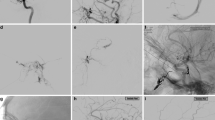Abstract
Purpose
Carotid cavernous fistulas (CCFs) are abnormal connections between the cavernous sinus (CS) and carotid arteries. In direct CCFs, a transarterial route is often the preferred vascular access; in case of indirect CCFs, the complex anatomy of the feeder vessels and their extra-intracranial anastomosis makes the transarterial embolization challenging and often ineffective. The aim of this study was to review our experience with the transorbital approach to treat patients affected by CCF who have already experienced an endovascular failure procedure, in order to assess this salvage technique feasibility, by analyzing possible risks and complications.
Methods
We performed a retrospective study of all patients affected by CCFs who underwent transorbital embolization between February 2017 and February 2019 at our institution.
Results
All patients (3 cases) tolerated both the retrograde embolization and the direct surgical approach with clinical improvement; the closure of the fistula was complete and verified intraoperatively by angiography. Esthetic result was acceptable in all cases with reduction of the proptosis and the intraocular pressure, and increased visual acuity. There were no complications or clinical recurrence.
Conclusion
Transorbital approach for the endovascular treatment of CCFs is a feasible and safe salvage procedure, which can find indication after other endovascular access failures.







Similar content being viewed by others
References
Barrow DL, Spector RH, Braun IF et al (1985) Classification and treatment of spontaneous carotid-cavernous sinus fistulas. J Neurosurg 62:248–256
Keltner JL, Satterfield D, Dublin AB, Lee BC (1987) Dural and carotid cavernous sinus fistulas: diagnosis, management, and complications. Ophthalmology 94:1585–1600
Kohyama S, Kaji T, Tokumaru AM, Kusano S, Ishihara S, Shima K (2002) Transfemoral superior ophthalmic vein approach via the facial vein for the treatment of carotid-cavernous fistulas: two case reports. Neurol Med Chir (Tokyo) 42(1):18–22
Leone G, Renieri L, Enriquez-Marulanda A et al (2019) Carotid cavernous fistulas and dural arteriovenous fistulas of the cavernous sinus: validation of a new classification according to venous drainage. World Neurosurg. https://doi.org/10.1016/j.wneu.2019.04.220
Ng PP, Higashida RT, Cullen S, Malek R, Halbach VV, Dowd CF (2003) Endovascular strategies for carotid cavernous and intracerebral dural arteriovenous fistulas. Neurosurg Focus. 15(4):ECP1
Uflacker R, Lima S, Ribas GC, Piske RL (1986) Carotid-cavernous fistulas: embolization through the superior ophthalmic vein approach. Radiology 159:175–179
Hanneken AM, Miller NR, Debrun GM, Nauta HJ (1989) Treatment of carotid-cavernous sinus fistulas using a detachable balloon catheter through the superior ophthalmic vein. Arch Ophthalmol 107:87–92
Monsein LH, Debrun GM, Miller NR et al (1991) Treatment of dural carotid-cavernous fistulas via the superior ophthalmic vein. AJNR Am J Neuroradiol 12:435–439
Locke CE (1924) Intracranial arterio-venous aneurysm or pulsating exophthalmos. Ann Surg 80(1):1–24
Dandy WE (1935) The treatment of carotid cavernous arteriovenous aneurysms. Ann Surg 102(5):916–926
Parkinson D (1967) Transcavernous repair of carotid cavernous fistula: case report. J Neurosurg 26(4):420–424
Serbinenko FA (1974) Balloon catheterization and occlusion of major cerebral vessels. J Neurosurg 41(2):125–145
Debrun G, Lacour P, Vineula F, Fox A, Drake CG, Caron JP (1981) Treatment of 54 traumatic carotid-cavernous fistulas. J Neurosurg 55(5):678–692
Brismar J (1974) Orbital phlebography. II. Anatomy of the superior ophthalmic vein and its tributaries. Acta Radiol Diagn (Stockh) 15:481–496
Brismar J (1974) Orbital phlebography III. Topography of the orbital veins. Acta Radiol Diagn (Stockh) 15:577–595
Cheung N, McNab AA (2003) Venous anatomy of the orbit. Invest Ophthalmol Vis Sci 44:988–995
Spinelli HM, Falcone S, Lee G (1994) Orbital venous approach to the cavernous sinus: an analysis of the facial and orbital venous system. Ann Plast Surg 33:377–383
Miller NR, Monsein LH, Debrun GM et al (1995) Treatment of carotid-cavernous sinus fistulas using a superior ophthalmic vein approach. J Neurosurg 83:838–842
Quiñones D, Duckwiler G, Gobin PY, Goldberg RA, Viñeula F (1997) Embolization of dural cavernous fistulas via superior ophthalmic vein approach. AJNR Am J Neuroradiol 18(5):921–928
Leibovitch I, Modjtahedi S, Duckwiler GR, Goldberg RA (2006) Lessons learned from difficult or unsuccessful cannulations of the superior ophthalmic vein in the treatment of cavernous sinus dural fistulas. Ophthalmology 113:1220–1226
Phan K, Xu J, Leung V, Teng I, Sheik-Ali S, Maharaj M, Mobbs R, Rao PJ (2016) Orbital approaches for treatment of carotid cavernous fistulas: a systematic review. World Neurosurg 96:243–251
Benndorf G, Bender A, Campi A, Menneking H, Lanksch WR (2001) Treatment of a cavernous sinus dural arteriovenous fistula by deep orbital puncture of the superior ophthalmic vein. Neuroradiology 43(6):499–502
Berkmen T, Triffkin NA, Wakhloo AK (2003) Transvenoussonographically guided percutaneous access for treatment of an indirect carotid cavernous fistula. AJNR Am J Neuroradiol 24(8):1548–1551
Heran MKS, Volders D, Haw C, Shewchuk JR (2019) Imaging-guided superior ophthalmic vein access for embolization of dural carotid cavernous fistulas: report of 20 cases and review of the literature. AJNR Am J Neuroradiol 40(4):699–702
Trivelato FP, Manzato LB, Filho PMM et al (2018) Transorbital cavernous sinus direct puncture: alternative to treat dural arteriovenous fistula. ClinNeuroradiol 28(1):55–61
Author information
Authors and Affiliations
Corresponding author
Ethics declarations
Ethics approval and consent to participate
This study was conducted in accordance with the current revision of the Declaration of Helsinki. Informed written consent form was obtained from all patients. Current standards of scientific research ethics were applied in the performance of this retrospective study. This study has never been presented at any meetings.
Conflict of interest
There is absence of conflict of interest.
Additional information
Publisher’s note
Springer Nature remains neutral with regard to jurisdictional claims in published maps and institutional affiliations.
Rights and permissions
About this article
Cite this article
Arcuri, F., Agostini, T., Limbucci, N. et al. Salvage transorbital approach for the endovascular treatment of carotid cavernous fistulas. Oral Maxillofac Surg 26, 45–51 (2022). https://doi.org/10.1007/s10006-021-00961-z
Received:
Accepted:
Published:
Issue Date:
DOI: https://doi.org/10.1007/s10006-021-00961-z




